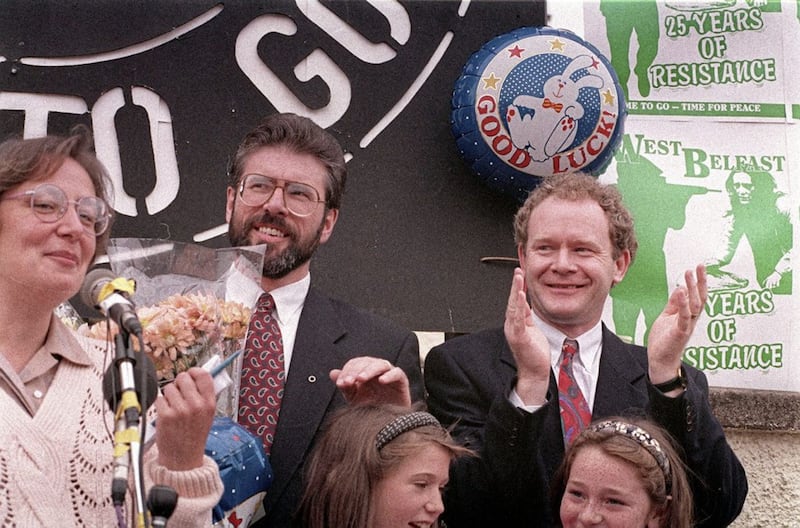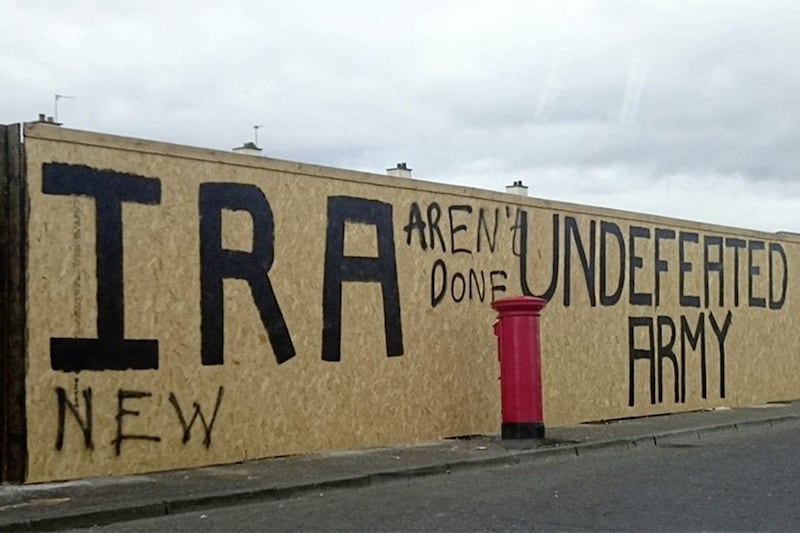What was the Provisional Irish Republican Army (PIRA)?
The Provisional Irish Republican Army (PIRA) was a militant republican paramilitary group which used physical force violence in an effort to destabilise the Northern Ireland state and force the withdrawal of the British Army to bring about a united Ireland.
Key Facts - IRA leaders and IRA bombings
Duration: The Provisional IRA was formed in December 1969 and officially ended its armed campaign in July 2005, after having called an initial ceasefire in 1994 and again in 1997.
Deaths: Between 1969 and 2005, the Irish Republican Army was responsible for 1,768 killings (47.5%) of the total 3,532 deaths on the Troubles. In total, 294 Provisional IRA members died during the same period.
Membership: It is estimated that the Provisional IRA had between 8,000 and 10,000 members overall during its 35-year campaign. Membership peaked at an estimated 1,500 during the mid 1970s although it is thought that from then on there were between 600 and 800 activists and auxiliary support at any one time.
Leadership: Major decisions were taken by a General Army Convention (GAC) with representatives from all levels of the organisation. GAC elected a 12 member Army Executive which in turn selected a 7 member Army Council (AC), responsible for policy making decisions. Day-to-day running of Provisional IRA operations was conducted by a General Headquarters (GH) department. At ground level, Provisional Irish Republican Army members acted within small groups of four to five members known as Active Service Units (ASUs).
Read more: Belfast pensioner's regret for saving IRA killer from rubble of Shankill bomb

History
The Provisional IRA was formed in December 1969 after a split within the IRA, the original Irish Republican Army, which was formed in 1919 and fought against the Irish Free State in the Irish Civil War in 1922. Between 1922 and 1969 its successor was an anti-treaty group opposed to the ruling political parties in the Irish state. In Northern Ireland it unsuccessfully tried to mount a number of armed rebellions against the northern state.
Meanwhile, a rival faction of the IRA was known as the Official IRA, while the more militant breakaway group became known as the Provisionals. While the Provisional IRA was initially the smaller of the two groups, by 1972 it had become the larger. Support for the PIRA grew because of the Stormont government’s decision to introduce internment without trial in August 1971, during which hundreds of males from the Catholic/nationalist/ republican (CNR) community were imprisoned without trial. British Army killings at Ballymurphy in Belfast in August 1971 when 11 OR 10 unarmed civilians were shot dead and some months later in Derry’s Bogside on January 30 1972 in what became known as Bloody Sunday when 14 unarmed people were shot dead, increased support from within the Catholic/nationalist/republican communities for the PIRA’s ‘armed struggle’.

Read more:
- Ballymurphy Inquest: Who were the people killed?
- Ballymurphy Inquest: A 20-year campaign for recognition and justice
While the PIRA carried out numerous gun and bomb attacks daily on the streets of Northern Ireland during the late 1970s, hundreds of its members were imprisoned at the Maze/H Blocks prison. A four-year protest by republican prisoners from 1976 over the British government’s decision to withdraw political/special category status, culminated in a series of hunger strikes in 1980 and the following year. In May 1981 IRA prison leader Bobby Sands became the first hunger striker to die after 66 days refusing food. Six other Provisional IRA and three Irish National Liberation Army (INLA) prisoners would also die before the hunger strike was ended.

However, support for hunger strikers who stood as anti-H Block candidates in a series of elections in 1981 indicated to the republican movement’s leadership that there was an untapped source of political support for their campaign. As a result, an ‘Armalite and Ballot Box’ strategy was adopted in which the PIRA would continue with its armed campaign but its political wing Sinn Fein would enter mainstream politics.

Read more: Who are Sinn Fein?
On October 12 1984, the Provisional IRA killed five members of the British Conservative Party and injured 31 others when it exploded a bomb at the Grand Hotel in Brighton, England. Prime Minister Margaret Thatcher and other cabinet members narrowly escaped being killed.

From the mid-1980s the leadership of the republican movement began to concentrate more of its resources towards increasing the political growth of Sinn Fein, however, the Provisional IRA’s use of physical force violence also continued, notably with the secret importation of a series of arms shipments of 1,000 assault rifles and six tonnes of explosives from Libyan leader Muammar Gaddafi.
Peace Talks
From the late 1980s Sinn Fein leader Gerry Adams began secret talks with SDLP leader John Hume in a bid to convince republicans to abandon armed violence and enter solely into democratic politics. In 1990 Sinn Fein deputy leader Martin McGuinness and party member Gerry Kelly were also engaged in secret talks with British government representatives.
Despite the secret talks to bring an end to the violence the Provisional IRA’s armed actions continued. In February 1991 it launched mortar bombs at 10 Downing Street in London where British prime minister John Major and his cabinet colleagues were meeting.

The secret peace talks eventually proved successful when, on August 31 1994, the PIRA announced a "cessation of military operations". Loyalist paramilitary groups called their own ceasefires six weeks later. The British government also announced a reduction of British Army installations and British soldiers were removed from the streets.
The PIRA’s ceasefire broke down after 19 months in February 1996 with the republican movement’s leadership accusing the British government and unionist politicians of ‘bad faith’ and deliberately squandering an opportunity to resolve the conflict.
Less than an hour later a huge bomb exploded in London’s Docklands killing two people and injuring 40 others. Four months later a similar bomb was exploded in Manchester city centre in the north of England, injuring 212.
The PIRA renewed its ceasefire in July 1997.

PIRA Decommissioning

A major political impasse to the establishment of a power-sharing Assembly at Stormont was unionist demands for the decommissioning of PIRA weapons and the republican group’s refusal to agree to destroy its arsenal.
The Good Friday Agreement/Belfast Agreement had included a requirement for all paramilitary group to have decommissioned by May 2000. This deadline and another on 30 June 2001 were missed, leading to Ulster Unionist leader David Trimble resigning as first minister. In August 2001 the PIRA finally agreed on a method to destroy its weapons.
Read more:
[ The inside story of how the gun was taken out of Irish politicsOpens in new window ]
In October 2001, April 2002, October 2003, and September 2005 the PIRA carried out a series of decommissioning acts which were independently verified by international experts who stated their belief that the “totality of the IRA’s arsenal” had been destroyed.
In July 2005 the PIRA officially announced an end to its armed campaign and called on its membership to cease all armed actions, stating that it would work to achieve its goals of a united Ireland through entirely peaceful means.
Did all Catholics/nationalists/republicans support the PIRA?

No. PIRA violence was regularly criticised by both the Irish government, Catholic Church and by the mainstream SDLP party, who were the largest political nationalist party in Northern Ireland throughout the Troubles.
How many people did the Provisional IRA kill?
The PIRA is thought to have been responsible for 1,768 deaths during the Troubles. Many of those deaths were civilians (639) and included atrocities such as a February 1978 fire-bomb attack on the La Mon Hotel on the outskirts of Belfast which killed 12 people and injured 30 others.

It also abducted, killed and secretly buried at least nine people who collectively became known as the Disappeared. Among them was widowed mother-of-10 children Jean McConville who was abducted in 1972 and her remains found on a Co Louth beach in 2003.

An estimated 454 members of the British Army and RAF were killed by the Provisionals, including 18 soldiers who died after the PIRA exploded two large bombs at Narrow Water near Warrenpoint, County Down, in August 1979.
The PIRA killed 273 members of the Royal Ulster Constabulary (RUC), 181 Ulster Defence Regiment (UDR) and Royal Irish Regiment (RIR) members, 20 Prison Service personnel, six members of British police forces, seven members of An Garda Siochana (the police force in the Republic of Ireland) and Irish army, 30 loyalist paramilitaries, 151 IRA members and other republican organisations during feuds and seven other deaths.
Does the IRA still exist?
The PIRA has not been blamed for any killings, bomb attacks or major incident since its July 2005 announcement. However, in 2015, following the killing of former Provisional IRA member Kevin McGuigan, then PSNI Chief Constable George Hamilton claimed that the PIRA still existed and that some of its members had been involved in Mr McGuigan’s murder in revenge for an earlier killing of Belfast republican Gerard Davison.
Mr Hamilton stated the PSNI belief that some of the PIRA structure from the 1990s remained in place but that the organisation remained committed to politics and was not engaged in terrorism.
“They are not on a war footing; they are not involved in paramilitary activity in the sense that they were during the period of the conflict.”









